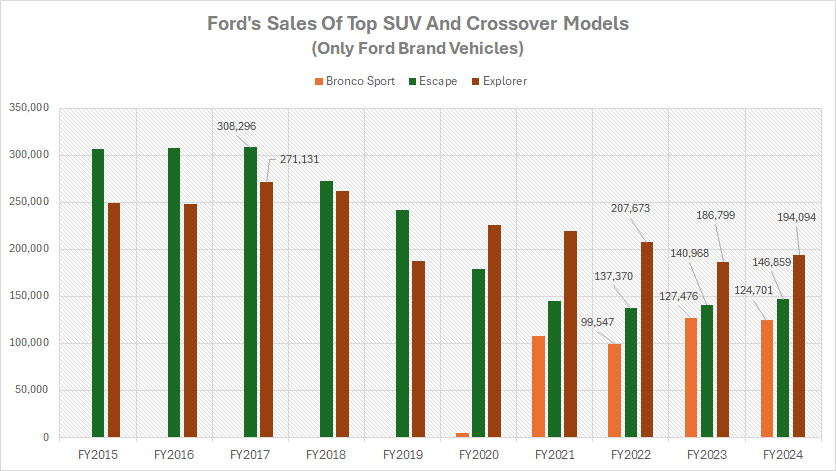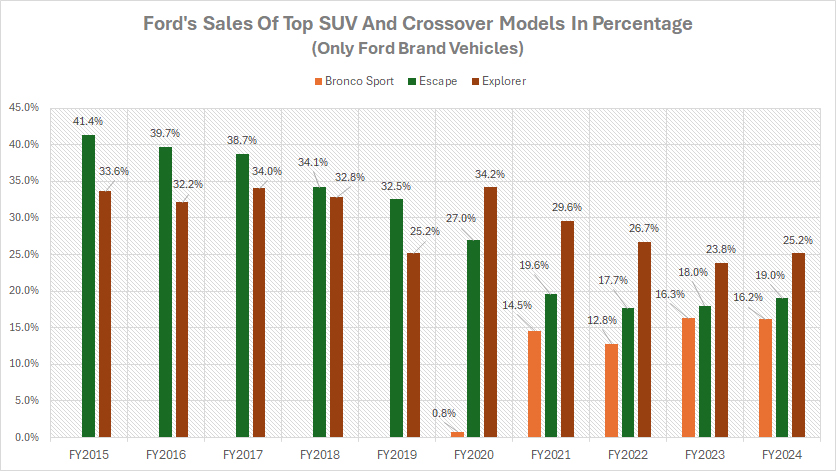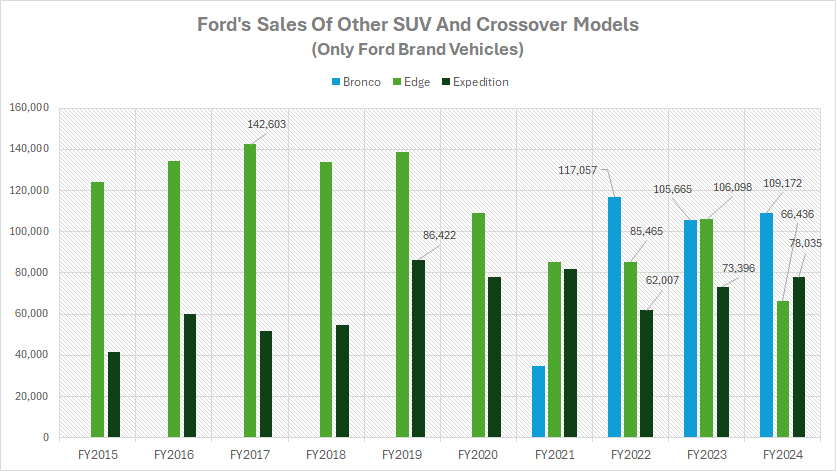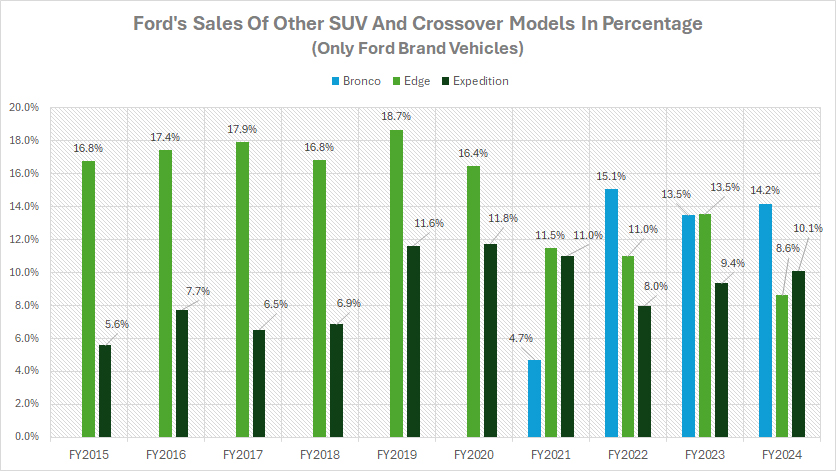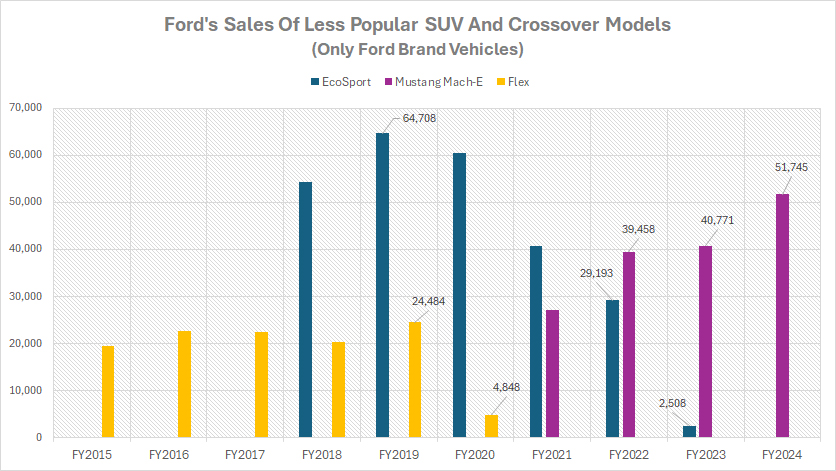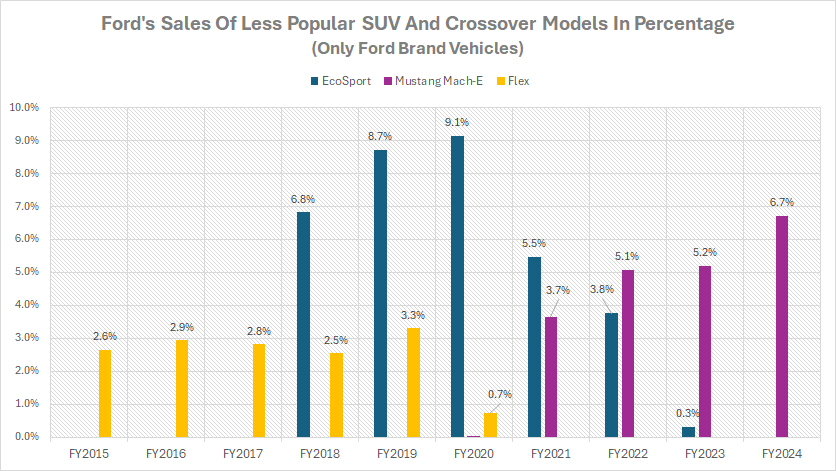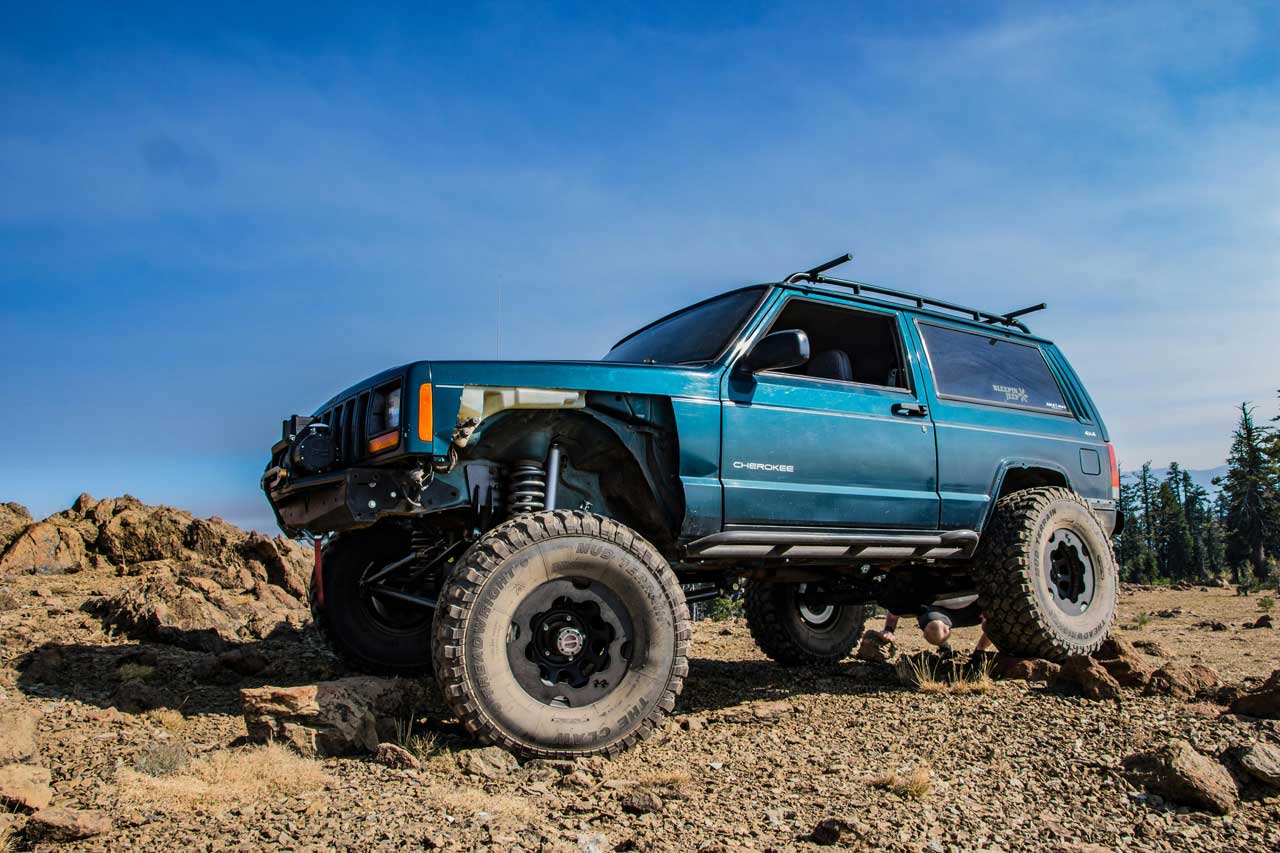
Off-road driving. Pexels Image.
This article presents Ford Motor Company’s retail sales of SUVs and crossovers in the U.S. The sales results discussed are exclusively for the U.S. market. Additionally, we focus solely on the retail sales data.
For other sales statistics of Ford Motor, you may find more information on these pages:
Please use the table of contents to navigate this page.
Table Of Contents
Definitions And Overview
O2. How Are Vehicle Retail Volumes Measured?
Top 3 SUV And Crossover Models
A1. Sales Of Explorer, Escape, And Bronco Sport
A2. Sales Of Explorer, Escape, And Bronco Sport In Percentage
Other SUV And Crossover Models
B1. Sales Of Bronco, Expedition, And Edge
B2. Sales Of Bronco, Expedition, And Edge In Percentage
Less Popular SUV And Crossover Models
C1. Sales Of Mustang Mach-E, EcoSport, And Flex
C2. Sales Of Mustang Mach-E, EcoSport, And Flex In Percentage
Conclusion And Reference
S1. Conclusion
S2. References and Credits
S3. Disclosure
Definitions
To help readers understand the content better, the following terms and glossaries have been provided.
Vehicle Retail Sales: Vehicle retail sales refer to the number of vehicles sold directly to consumers through retail channels, such as dealerships.
This metric typically includes sales of new and used cars, trucks, and other types of vehicles. Vehicle retail sales provide insight into consumer demand and purchasing behavior in the automotive market.
Key points to consider about vehicle retail sales:
- New vs. Used Vehicles: Retail sales can encompass both new and used vehicles sold to individual customers.
- Dealerships: The sales typically occur through authorized dealerships, which serve as the primary retail outlets for car manufacturers.
- Consumer Demand: Retail sales figures help gauge consumer demand and market trends within the automotive industry.
- Exclusions: These figures generally exclude fleet sales (e.g., sales to rental car companies, government agencies, and corporate fleets) and wholesale transactions.
Understanding vehicle retail sales is crucial for manufacturers, dealerships, and market analysts to assess the health and trends of the automotive market.
Bronco: The Ford Bronco is a model line of SUVs manufactured by Ford Motor Company. Introduced in 1965, the Bronco was one of the first SUVs and has gone through several generations.
The original Bronco was designed as a compact off-road vehicle to compete with the Jeep CJ-5 and International Scout. Over the years, the Bronco evolved, with the last generation produced in 1996.
In 2021, Ford revived the Bronco name with a new mid-size two-door SUV and a full-size four-door SUV, both designed for off-road adventures and competing directly with the Jeep Wrangler.
Bronco Sport: The Ford Bronco Sport is a compact crossover SUV introduced by Ford Motor Company in 2020.
It is part of the revived Bronco family, designed to offer off-road capabilities similar to its larger sibling, the Ford Bronco, but in a smaller and more city-friendly package.
The Bronco Sport is equipped with standard 4×4 and a Terrain Management System with up to seven G.O.A.T. (Goes Over Any Type of Terrain) modes to tackle various driving conditions.
It offers two turbocharged engines: a 1.5-liter three-cylinder engine and a more powerful 2.0-liter four-cylinder engine. The Bronco Sport features a rugged, boxy design with a distinctive front grille and round headlights, reminiscent of the classic Bronco.
Escape: The Ford Escape is a compact crossover SUV that has been a popular model in Ford’s lineup since its introduction in 2000.
Known for its balance of comfort, utility, and technology, the Escape is a versatile vehicle suitable for both city driving and weekend getaways.
The Escape offers a variety of powertrains, including a standard gasoline engine, an efficient hybrid, and a plug-in hybrid option. This range caters to different driving preferences and fuel efficiency needs.
Explorer: The Ford Explorer is a mid-size SUV that has been a key model in Ford’s lineup since its introduction in 1990. Known for its versatility and family-friendly features, the Explorer has undergone numerous updates and redesigns over the years.
The Explorer provides a range of powertrain options, including a turbocharged four-cylinder engine, a V6 engine, and a hybrid variant. These options cater to different performance and fuel efficiency preferences.
The Explorer is known for its impressive towing capabilities, making it suitable for hauling trailers, boats, and other heavy loads. The Explorer typically offers seating for up to seven passengers with a spacious interior, making it a popular choice for families. The third-row seats can be folded to increase cargo space when needed.
Expedition: The Ford Expedition is a full-size SUV that has been a prominent model in Ford’s lineup since its introduction in 1996.
Known for its spacious interior, powerful performance, and robust towing capacity, the Expedition is designed to cater to families and individuals who require a versatile and capable vehicle.
The Expedition typically offers seating for up to eight passengers with a roomy interior. The second and third rows can be configured to maximize passenger comfort or cargo space as needed.
The Expedition is powered by a 3.5-liter EcoBoost V6 engine, delivering impressive horsepower and torque for strong performance and towing capabilities.
Edge: The Ford Edge is a mid-size crossover SUV that offers a balance of performance, comfort, and technology. It has been part of Ford’s lineup since its introduction in 2006.
The Edge offers a range of engine options, including a turbocharged four-cylinder engine and a more powerful V6 engine. It is known for its smooth ride and responsive handling.
The Edge is available in several trim levels, including the sportier ST model, which offers enhanced performance and sporty styling.
Mustang Mach-E: The Ford Mustang Mach-E is an all-electric SUV introduced by Ford Motor Company in 2020. It combines the performance and iconic design elements of the classic Ford Mustang with the practicality and environmental benefits of an electric vehicle.
The Mustang Mach-E offers various powertrain options, including standard and extended-range battery packs, with rear-wheel drive or all-wheel drive configurations. The GT and GT Performance Edition trims provide enhanced performance with impressive acceleration.
Depending on the battery and drivetrain configuration, the Mach-E offers an estimated range of up to 305 miles on a single charge. The Mach-E includes advanced driver-assist features through Ford Co-Pilot360, as well as hands-free driving capabilities with Ford’s BlueCruise system (available in certain models).
How Are Vehicle Retail Volumes Measured?
Vehicle retail volumes in the U.S. are measured through a systematic process that involves tracking and analyzing the number of new vehicles sold to consumers through dealerships. Here are the key steps involved in measuring vehicle retail sales:
- Data Collection: Dealerships report their sales figures to automotive manufacturers and industry organizations. These reports include detailed information on the number of vehicles sold, categorized by model, make, and other relevant criteria.
- Centralized Reporting: The collected data is aggregated by automotive manufacturers and industry organizations such as the National Automobile Dealers Association (NADA) and the Automotive News Data Center. These organizations compile and maintain comprehensive sales databases.
- Seasonal Adjustment: Sales data is often adjusted for seasonal variations to provide a clearer and more accurate representation of underlying sales trends. This adjustment accounts for predictable fluctuations in sales that occur throughout the year.
- Monthly Reports: The adjusted sales figures are typically reported on a monthly basis. Key industry players such as the U.S. Bureau of Economic Analysis (BEA), Automotive News, and other industry publications release detailed monthly sales reports.
- Market Analysis: Analysts and researchers use the reported sales data to analyze market trends, consumer preferences, and the overall health of the automotive industry. This analysis helps identify patterns, forecast future sales, and make informed business decisions.
- Comparisons and Benchmarks: Sales data is often compared with historical data, competitor sales, and industry benchmarks to assess performance. This comparative analysis helps determine how well a particular brand or model is performing relative to others in the market.
By systematically collecting, reporting, and analyzing sales data, the U.S. automotive industry ensures that vehicle retail sales are accurately measured and understood.
Sales Of Explorer, Escape, And Bronco Sport
ford-sales-of-top-selling-suv-models
(click image to expand)
The definition of Ford’s vehicle retail sales is available here: vehicle retail sales. You can find more information about Ford’s best-selling SUV models here: Explorer, Escape, and Bronco Sport.
Ford’s top three best-selling SUV models in the U.S. market were the Explorer, Escape, and Bronco Sport in fiscal year 2024, as shown in the chart above.
In fiscal year 2024, Ford’s retail sales volume for the Explorer reached 194,100 units, making it the company’s top-selling SUV model. During the same period, the company sold 146,900 units of the Escape. The Bronco Sport ranked third, achieving approximately 124,700 units in sales.
Although the Explorer and Escape have achieved significant sales volumes, their results have considerably declined, as illustrated in the chart above. For instance, Ford’s sales of the Escape peaked at over 308,300 units in fiscal year 2017. Since then, the Escape has experienced a steady decline in sales volume, reaching just 146,900 units in fiscal year 2024.
A similar trend was observed with the Explorer. For instance, Ford’s sales of the Explorer peaked at over 271,100 units in fiscal year 2017. Since then, the sales of the Explorer have been on a decline, reaching 194,100 units in fiscal year 2024, one of the new lows over the past ten years.
Ford’s sales of the Bronco Sport have been quite steady in recent years. The retail volume of the Bronco Sport has remained above 120,000 units annually since 2023, marking a significant increase from the 99,500 units recorded in fiscal year 2022.
Ford has successfully tapped into the growing demand for compact SUVs with the Bronco Sport, appealing to consumers seeking a versatile and capable vehicle. This strategic approach has led to strong sales of the model.
Sales Of Explorer, Escape, And Bronco Sport In Percentage
ford-sales-percentage-of-top-selling-suv-models
(click image to expand)
The definition of Ford’s vehicle retail sales is available here: vehicle retail sales. You can find more information about Ford’s best-selling SUV models here: Explorer, Escape, and Bronco Sport.
In fiscal year 2024, within Ford’s SUV segment, the Explorer accounted for approximately 25% of the automaker’s total SUV volume in the U.S. The Escape comprised 19%, while the Bronco Sport contributed 16%.
Although the Explorer and Escape have contributed significantly to Ford’s total SUV sales in the U.S. market, their sales contributions have declined considerably, as illustrated in the graph above.
For instance, the sales contribution of Ford’s Escape decreased from 41% in fiscal year 2015 to just 19% in fiscal year 2024. Similarly, the sales contribution of Ford’s Explorer declined from 34% in fiscal year 2015 to 25% in fiscal year 2024.
In contrast, the sales contribution of Ford’s Bronco Sport has remained strong since 2021, significantly increasing from 14.5% in fiscal year 2021 to 16.2% in fiscal year 2024.
Several factors have driven the steady demand for Ford’s Bronco Sport. For example, the Bronco nameplate carries significant brand appeal, boasting a strong heritage and reputation. This has attracted loyal Ford customers and enthusiasts of off-road vehicles.
Additionally, Ford has launched effective marketing campaigns for the Bronco Sport, successfully highlighting its strengths, such as off-road capabilities and rugged design, which resonate well with target customers.
Also, the Bronco Sport is widely regarded as an excellent SUV, earning positive reviews from automotive critics and consumers alike. Its performance, comfort, and value for money have been particularly praised, contributing to its strong sales.
Sales Of Bronco, Expedition, And Edge
ford-sales-of-other-suv-models
(click image to expand)
The definition of Ford’s vehicle retail sales is available here: vehicle retail sales. You can find more information about Ford’s other SUV models here: Bronco, Expedition, and Edge.
The Bronco, Expedition, and Edge are also among Ford’s top-selling SUV and crossover models. Although their sales numbers may not match those of the Explorer, Escape, and Bronco Sport, they have significantly contributed to the overall success of Ford’s SUV lineup.
In fiscal year 2024, Ford sold over 109,200 units of the Bronco in the U.S. market. During the same period, the Expedition achieved 78,000 units in sales, while the Edge saw 66,400 units sold.
Ford’s sales of the Bronco in the U.S. market have remained relatively strong since fiscal year 2021, averaging over 110,000 units annually. The Expedition has also shown consistent performance, with sales averaging 71,100 units annually.
Notably, the Expedition’s sales have increased significantly from 62,000 units in 2022 to 78,000 units in 2024, marking a growth rate of 26% over two years.
However, Ford’s sales of the Edge were considerably low in fiscal year 2024, reaching only 66,400 units, which is roughly 37% lower than the previous year.
Over the long term, the Expedition has performed well in the U.S. market, with sales nearly doubling over ten years, rising from 40,000 units in fiscal year 2015 to 78,000 units in fiscal year 2024.
In contrast, the sales performance of the Edge has been less impressive. Since fiscal year 2015, Ford’s sales of the Edge has decreased from over 100,000 vehicles annually to just 66,400 vehicles annually as of fiscal year 2024.
Moreover, the sales of the Edge peaked at over 142,600 units in fiscal year 2017. Since then, the retail volumes of this model have been declining. This downward trend in sales volume highlights the challenges the Edge has faced in a competitive market, where newer and more appealing models have drawn consumers’ attention away from older offerings.
Sales Of Bronco, Expedition, And Edge In Percentage
ford-sales-percentage-of-other-suv-models
(click image to expand)
The definition of Ford’s vehicle retail sales is available here: vehicle retail sales. You can find more information about Ford’s other SUV models here: Bronco, Expedition, and Edge.
In fiscal year 2024, the Bronco accounted for approximately 14% of Ford’s overall SUV retail volume within the U.S. market, making it the fourth largest SUV model by sales volume. During the same period, the Expedition contributed 10%, while the Edge represented 8.6%.
The sales contribution of the Bronco has remained solid over the past three years, averaging around 14% of Ford’s total SUV sales. The Expedition has also shown relative stability since 2022, with its sales contribution increasing from 8% to 10%.
However, the sales contribution of the Edge peaked at over 18.7% in fiscal year 2019. Since then, it has significantly declined, dropping to just 8.6% in fiscal year 2024.
The primary factor driving the decrease in the sales contribution of the Edge is Ford’s announcement in 2023 that the model would be discontinued. This announcement has likely affected consumer confidence and interest in purchasing the Edge, leading to its declining sales.
Additionally, the Edge has also faced stiff competition from newer and more advanced models from rivals such as the Nissan Murano, Chevrolet Blazer, Jeep Grand Cherokee, and Hyundai Santa Fe. These competitors offer similar features and often at competitive prices, drawing customers away from the Edge1.
Sales Of Mustang Mach-E, EcoSport, And Flex
ford-sales-of-less-popular-suv-models
(click image to expand)
The definition of Ford’s vehicle retail sales is available here: vehicle retail sales. You can find more information about Ford’s other SUV models here: Mustang Mach-E.
Ford has discontinued both the EcoSport and Flex models. Meanwhile, the new Mustang Mach-E has seen impressive sales in the U.S. market, with Ford selling over 51,700 vehicles in fiscal year 2024.
Furthermore, the Mustang Mach-E has experienced significant sales growth since its debut in fiscal year 2021. Ford’s sales of the Mustang Mach-E have risen from less than 30,000 vehicles to over 51,700 vehicles over the span of four years, representing growth of over 70%.
Ford’s sales of the Mustang Mach-E have been increasing, but there are a few reasons why they might not be as high as expected. Like many automakers, Ford may have experienced supply chain disruptions that have affected production and delivery timelines.
Besides, the electric vehicle (EV) market is highly competitive, with strong rivals like Tesla leading the way. The Model Y, for example, has been a dominant player, making it challenging for the Mach-E to capture a larger market share.
Sales Of Mustang Mach-E, EcoSport, And Flex In Percentage
ford-sales-percentage-of-less-popular-suv-models
(click image to expand)
The definition of Ford’s vehicle retail sales is available here: vehicle retail sales. You can find more information about Ford’s other SUV models here: Mustang Mach-E.
In fiscal year 2024, Ford’s sales of the Mustang Mach-E accounted for 6.7% of the company’s total SUV volume in the U.S. market. This ratio has significantly increased since 2021, rising from 3.7% to 6.7% over four years. In contrast, the EcoSport and Flex models have been discontinued, contributing nothing to Ford’s SUV sales.
Despite facing multiple challenges, the Mustang Mach-E has demonstrated impressive sales growth and remains a crucial element of Ford’s electrification strategy. The model’s sales contribution of 6.7% in fiscal year 2024 represents its highest achievement since its debut in 2020.
For this fully-electric SUV model, Ford may have faced higher production costs, which has impacted profitability. The company has been working to bring down these costs, but it remains a challenge.
Besides, consumers remain hesitant to transition from traditional gasoline-powered vehicles to EVs, which can slow down the adoption rate of new EV models like the Mach-E.
As a result, Ford’s sales of the Mustang Mach-E have remained modest. We will see if the situation will improve as consumer confidence in electric vehicles increases and the company continues to enhance its offerings and address market challenges.
Conclusion
In summary, while some models have seen a decline in sales, others like the Bronco Sport and Mustang Mach-E have experienced significant growth, contributing to the overall diversity and success of Ford’s SUV lineup.
References and Credits
1. All vehicle sales data presented in this article were obtained and referenced from Ford’s car sales reports published in the company’s investor relation page: Ford’s Car Sales Reports.
2. Pexels Images.
Disclosure
References and examples such as tables, charts, and diagrams are constantly reviewed to avoid errors, but we cannot warrant the total correctness of all content.
The content in this article is for informational purposes only and is neither a recommendation nor a piece of financial advice to purchase a stock.
If you find the information in this article helpful, please consider sharing it on social media and providing a link to it from any website so that more articles like this can be created.
Thank you!

